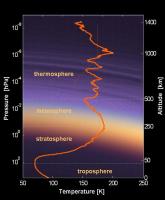Printable Version of Topic
Click here to view this topic in its original format
Unmanned Spaceflight.com _ Titan _ "Dewdrop" spotted on Titan..?
Posted by: Stu Dec 16 2008, 07:15 AM
http://blog.wired.com/wiredscience/2008/12/titanmethane.html
Posted by: tty Dec 16 2008, 08:44 PM
Would methane dew really collect on Huygens? I would expect the probe to be warmer than its surroundings, not colder.
Posted by: centsworth_II Dec 17 2008, 04:14 PM
The last 50km of the descent exposed Huygens to colder temperatures. I recollect that methane was evaporated from the surface by the 'hot' intake for the mass spectrometer. However, I expect that the rest of the probe's exterior was cold, being well insulated from the warm interior.
http://www.obspm.fr/actual/nouvelle/nov05/titan.en.shtml
Posted by: ugordan Dec 17 2008, 04:36 PM
Also, keep in mind that Huygens was thermally insulated pretty well so on the outside it could have conceivably cooled to ambient temperature.
Posted by: MahFL Dec 18 2008, 12:04 PM
You know it's nice to remember we have pictures from the surface, I had not seen that in many months and it brings back a nice warm feeling of a successful mission. ![]()
Posted by: rlorenz Dec 18 2008, 02:21 PM
exactly - see my analysis of the thermal interaction of Huygens with its environment
http://www.lpl.arizona.edu/~rlorenz/huygens_thermal.pdf
Posted by: tty Dec 18 2008, 07:41 PM
As far as I can see you estimate in the paper that the skin temperature of Huygens was 5 K above ambient at landing rising to "a few tens of K above ambient" which I should think would preclude condensation.
Posted by: centsworth_II Dec 19 2008, 08:14 AM
From the link in the opening post:
"Scientists think heat from the probe caused humid air to rise and condense on the cold edge of the craft."
I think protruding edges would be closer to the ambient temperature than would the overall surface temperature of the probe. And since the ambient temperature quickly rose 24 degrees before impact: "....just prior to surface impact, although the environmental temperature increases from 70 to 94 K...." (from Ralph Lorenz's paper), I can see how it would be possible for protruding edges such as those around the DISR to be colder than the surface ambient temperature for a while after landing.
Posted by: rlorenz Dec 19 2008, 02:48 PM
As long as a surface like the DISR baffle is cooler than the ground spot heated by the lamp you
can have condensation
Powered by Invision Power Board (http://www.invisionboard.com)
© Invision Power Services (http://www.invisionpower.com)

